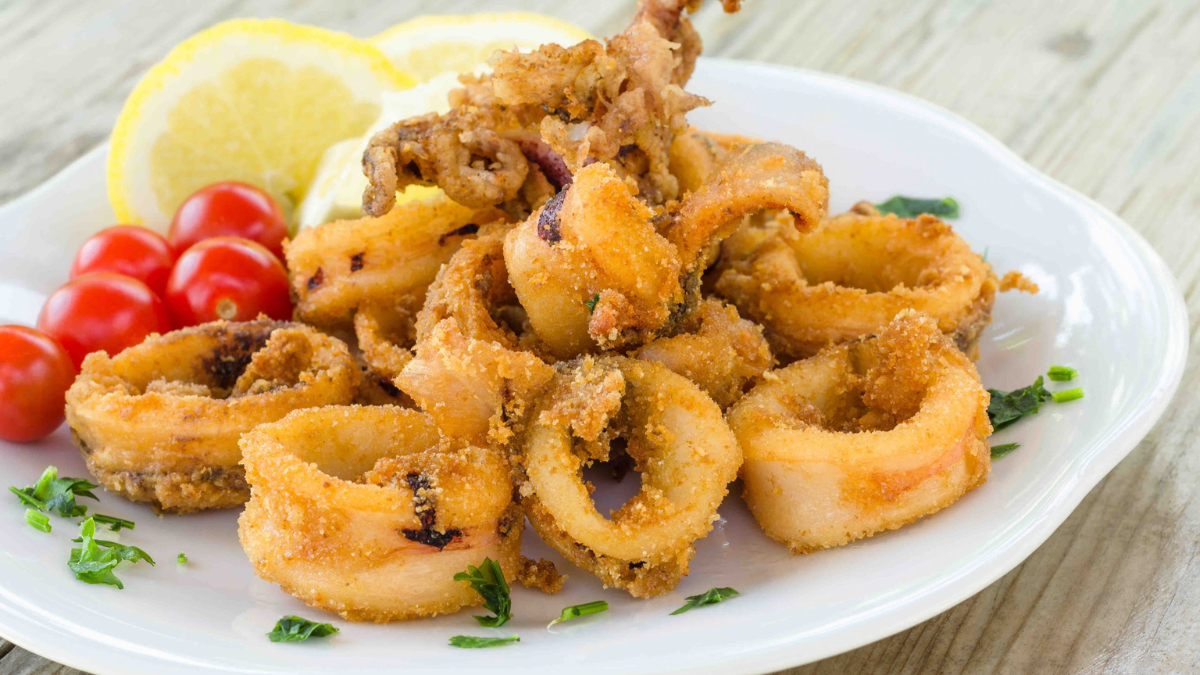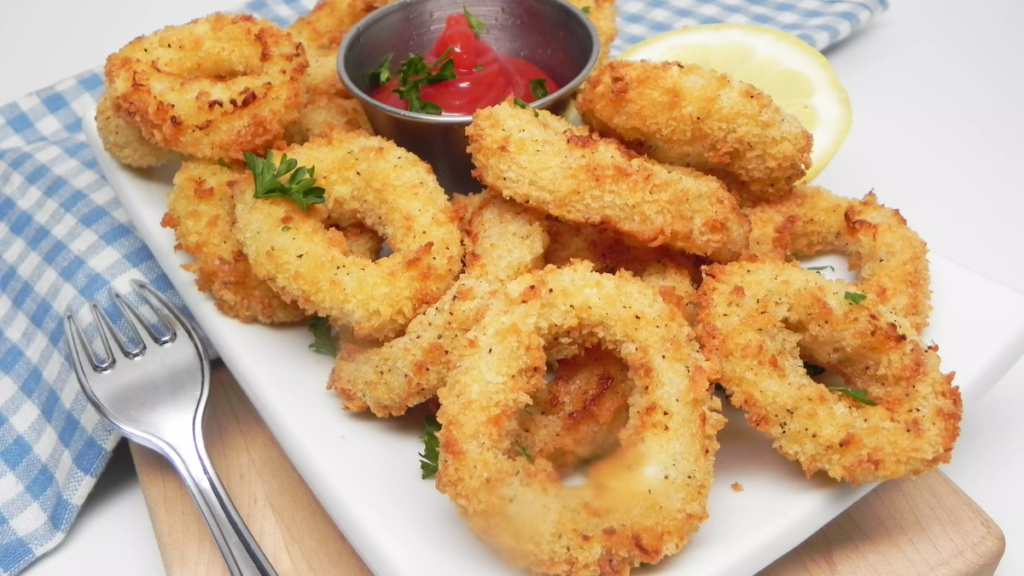Squid is a widely consumed seafood in every country. Tiv youIt’s affordable, adaptable, and delicious. It is suitable for grilling, searing, boiling, braising, and even eating raw as sashimi. Cut, breaded, and fried squid are the most widely consumed preparations. Although any squid consumed as food falls under the umbrella word “calamari,” this is commonly called calamari. Calories-wise, fried calamari is higher than most other calamari preparations. This article will give you all the crucial information about squid nutrition facts.
Often taken offshore and perhaps quite far out at sea, squid is caught for commercial usage. The most lucrative fishery in the world right now is for huge flying squid. It is common to see and eat different species of squid. The four squid species most frequently observed in 2002 were the Japanese flying squid, the jumbo flying squid, the Argentine shortfin squid, and the European squid.
What is Squid?
Squids are ten-armed marine cephalopods in various sizes, from tiny to enormous, in the world’s oceans. The order Teuthoidea, which includes all the animals with this name, contains many different families. Due to their vast distribution, they are present in various cuisines, mainly fried or sauteed foods. , due to their immense distributionMarine biologists also examine these organisms.
The squid’s traditional body shape is elongated, with two fins on one end stabilizing it while it swims. It has ten arms and two larger tentacles for manipulating and grasping food. The mantle, a malleable layer of tissue covering the body, shields the sensitive inside organs. The squid’s pen, a rigid protrusion inside the veil, is all that of the creature’s earlier, shelled predecessors.
Squid Nutrition Facts
Here’s a table of nutrition facts for squid, based on 100 grams per serving with the percent daily values based on a 2,000-calorie diet:
| Nutrient | Amount Per Serving | % Daily Value |
| Calories | 92 | 5% |
| Total Fat | 1.4g | 2% |
| Saturated Fat | 0.4g | 2% |
| Trans Fat | 0g | |
| Cholesterol | 233mg | 78% |
| Sodium | 44mg | 2% |
| Total Carbohydrate | 3g | 1% |
| Dietary Fiber | 0g | 0% |
| Total Sugars | 0g | |
| Protein | 18g | 36% |
| Vitamin D | 0.6mcg | 3% |
| Calcium | 34mg | 3% |
| Iron | 1.4mg | 8% |
| Potassium | 252mg | 5% |
It’s important to remember that these figures may change the bremembersquid’s precise variety and preparation meths quid’s od. Squid is also a good source of maids crucial for heart health.
Squid Health Benefits
Squid’s high protein content is frequently cited as one of its health benefits. Its polyunsaturated fatty acid content, usually omega-3 fatty acids, is linked to further advantages.
Healthy Pregnancy
Fish is recommended as a healthful food for pregnant or breastfed women by the U.S. Food and Drug Administration. For pregnant women, squid’s protein and iron content are especially crucial.
Heart Health
Research on the relationship between fish oil’s omega-3 fatty acids and heart health is extensive. However, calamari oil has a slightly different ratio of fatty acids than most fish oils on the market.
Squid has a higher fatty acid docosahexaenoic acid (DHA) concentration than other seafood. Oils high in DHA, such as calamari oil, may also aid women’s platelet aggregation.
Rheumatoid Arthritis
Omega-3 fatty acids, which are included in seafood, have been shown in studies to relieve the signs and symptoms of rheumatoid arthritis. Participants in a study experienced less joint discomfort and swelling and shorter morning stiffness periods.
Potential Risks of Squid
In moderation, squid is usually regarded as a safe food. Squid and shellfish provide the greatest health concerns due to their high mercury content and allergies.
Shellfish Allergy
Squid poses the same allergy risk as any other shellfish. It is most likely caused by a molecule called tropomyosin. Squid should be avoided if you are allergic to shellfish.
Mercury Poisoning
According to the FDA, squid is one of the “Best Choices” for seafood because it has a low mercury content. Mercury accumulation in the body can have major negative effects, especially in young children. Nevertheless, it’s a good idea to remember that any squid you eat probably includes mercury.
Adults are advised to consume 4-ounce squid and other “Best Choices” seafood no more than two or three times a week. The suggested serving size for kids aged two to eleven is one ounce.
It’s High in Vitamins that Support Brain and Nerve Function
A 4-ounce portion of squid provides more vitamin B12 than you need each day. According to the Harvard T.H. Chan School of Public Health, vitamin B12 is required by the body to produce red blood cells and has a role in your brain and nervous system health.
The homocysteine protein, connected to an increased risk of heart disease, stroke, Alzheimer’s, dementia, and cognitive decline, is broken down by vitamin B12, according to the Harvard T.H. Chan School of Public Health.
A 4-ounce meal of squid provides you with roughly 17 percent of your DV for magnesium. According to the NIH, magnesium plays a role in our bones and DNA development as we undulate blood pressure, blood sugar levels, and muscle and neuron function.
How to Prepare Squid?
Squeeze lemon juice over your cooked squid to add flavor and vitamin C. SqGrilledsautéed, baked, steamed, or boiled squid ll be lower in sodium and saturatedGrilled.
Squid can be added to seafood stews squid or substituted for grilled chicken or turkey in chef salads by grilling and slicing it. Put a unique spin on the traditional fish taco by placing cooked squid into corn tortillas and topping them with tomatoes and avocado.
Squid vs. Shrimp
Squid and shrimp are two of the most well-liked options for cooking seafood. When comparing squid with shrimp, you’ll first notice how different their bodies and outward appearances are. It would be easier to choose which complements the dish and your preferences if you knew how to recognize them and their nutritional variations.
Shrimp, a crustacean, has its distinctive outer shell covering, but squid, a mollusk, has neither an outside blanket nor a body. Shrimp tastes similar to chicken with a slight sharpness, while squid is moderately sweet and delicate to the palate. Both can easily become chewy if overdone.
Is Squid Good for High Blood?
Squid has no carbohydrates. Therefore, carb-averse-protein addicts and those following the ketogenic diet can incorporate it into your diet—a good source of vitamins B6 and 12. Your body requires vitamin B6 to protect your heart from strokes and vitamin B12 to maintain the health of your blood and neurological tissue.
Squid steamed or boiled has 482 milligrams of potassium per 4-ounce serving, or 10% of the recommended daily intake (DV). According to the Linus Pauling Institute at Oregon State University, potassium helps maintain low blood pressure. It fosters a healthy heartbeat—the total and saturated fat amount increases when squid is deep-fried.
Food that was once quite healthy is now harmful and high in cholesterol. Squid, however, can be quite nutritious if eaten grilled or steamed due to its low saturated fat content.Omega-3 fatty acids are abundant in fatty fish like mackerel and salmon and can lower triglycerides, blood pressure, and inflammation. Besides these fish sources, trout also has vitamin D in it.
Can People with Diabetes Eat Squid?
A squid is a fantastic option for people who wish to increase their protein consumption without sacrificing caloric intake. And it has a few calories. Because of this, squid or calamari is a very nourishing food. The American Diabetes Association (ADA) concurs with these suggestions for people with diabetes.
Another fish that is suitable for people with diabetes is shrimp. According to the USDA, a 4-oz serving of shrimp has 120 calories and roughly 23 grams of protein. Shrimp has more saturated fat per serving than the other seafood on this list (approximately 170 mg).
Although eating cold water fish in moderation—such as tuna, salmon, and trout—can raise uric acid levels, there may be higher cardiovascular benefits than risks of gout attacks. The occasional consumption of mussels, scallops, squid, shrimp, oysters, crab, and lobster is advised.
Is Squid Anti-Inflammatory?
Omega-3 is essential to human health and contains anti-inflammatory qualities that may reduce the risk of certain chronic diseases, according to a study. Squid contains less saturated fat than certain other animal products. It is accompanied by tartar sauce in Lebanon and Syria. Health specialists frequently advise against saturated and trans fats for people with elevated cholesterol.
The high protein, low fat, and low-calorie composition of squid make it a popular seafood choice. The research is conflicting on its anti-inflammatory abilities, though. On the other hand, squid also contains a high amount of purines, which can trigger inflammation in some people, especially those with gout or other inflammatory conditions.
OWhilesquid may have some anti-inflammatory properties due to its omega-3 content, but its potential to cause inflammation due to its purine content means that it may not be the best choice for those looking to reduce inflammation in the body. As with any food, it is important to consider your health needs and consult a healthcare professional if you have any concerns.
https://youtu.be/rYSDMSomdvU

